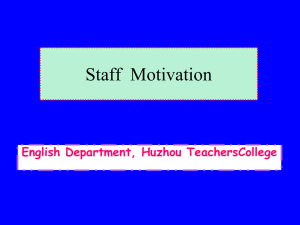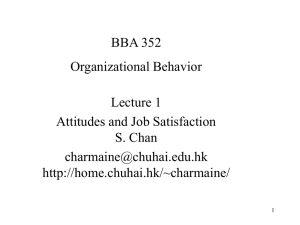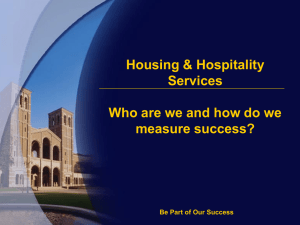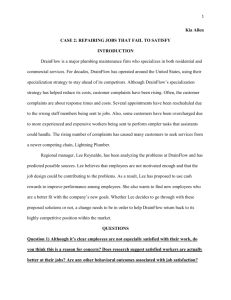Building Best-In-Class Employee Engagement Programs *both
advertisement
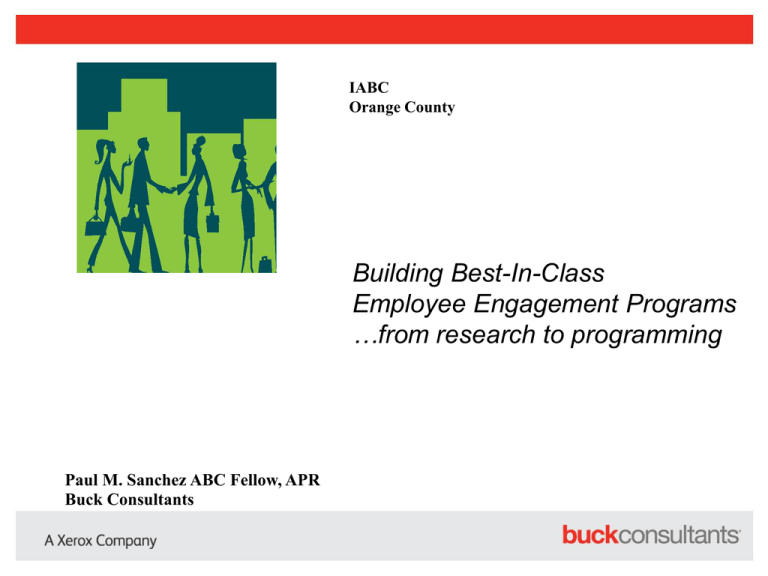
IABC Orange County Building Best-In-Class Employee Engagement Programs …from research to programming Paul M. Sanchez ABC Fellow, APR Buck Consultants Overview 1. From Satisfaction to Engagement 2. Defining Employee Engagement and the relationship to organization culture 3. Getting a Handle on Engagement 4. Stages of Employee Engagement 5. Program Implications (Communications and HR) 6. Conclusion and Discussion 2 Purpose of this session 1. To explore the topic of employee engagement 2. How these insights can inform and guide the development of Communications and HR programs 3. Highlight the role of Communications in various enterprise aspects. 4. Discuss your views on this topic 3 Defining Engagement… Why is a definition needed? 4 From Satisfaction to Engagement Research1 has clearly established that work environment perceptions influence a range of positive organizational performance outcomes Satisfaction, Commitment and Engagement Organization Performance - Employee Retention - Productivity - Market Share 1See, for example, Harter, J.K., Schmidt, F.L., & Hayes, T.L. Business-unit-level Relationship Between Employee Satisfaction, Employee Engagement, and Business Outcomes: Meta-Analysis. Journal of Applied Psychology, 87(2), 268279. 5 - Customer Satisfaction - Safety Behaviors From Satisfaction to Engagement Over time, the drivers of employee satisfaction and commitment have evolved 1980s Pay equity Job security Personal accomplishment Employee Satisfaction Opportunities for input 1990s Professional development Personal accomplishment Clear sense of company direction Employee Commitment Opportunities for input Work/life balance 6 From Satisfaction to Engagement Over the last decade, employers’ focus has moved beyond just “satisfied” or even “committed” employees, to employees who are “engaged” Satisfaction Satisfied with pay, benefits, supervisor, working conditions, etc. Commitment Not indifferent to the organization…willing to stay 7 Engagement ? From Satisfaction to Engagement Although there are some country-specific drivers, a consistent set of engagement drivers is emerging globally Engagement Drivers in this Century The work itself, including opportunities to grow Employee Engagement and Business Results Confidence and trust in leadership Recognition and rewards Communication 8 Employment Value Chain From Strategy to Performance Results Business Environment Company Strategy Brand values Human Resources Strategy & Organization Communications Employee Perceptions & Behaviors Business Performance - Employee Retention - Customer Satisfaction - Performance - Quality Metrics How employees experience their work environment has a critical impact on business results 9 …Defining Employee Engagement 10 Defining Employee Engagement 1. Engagement is the result of how employees perceive the work experience–the company, its leaders, the work itself, the communication climate and colleagues 2. Employee engagement manifests itself as: • • • • • A willingness to go the extra mile Motivation to perform to the highest standards Creative energy applied to work tasks and duties Customer orientation A vested interest in the company’s success 3. Employee Engagement is both a reflection of the culture and primary force is shaping the culture 11 Culture Culture: The patterns of behavior the organization and its people reward and sustain. “The way things get done around here.” Culture: The sum of all factors that make an organization and its people unique and identifiable Culture: The way that an organization’s stated values are internalized and thus influence the building blocks: • Strategy • Structure • People • Processes Employee engagement is both an outcome of and a force in forging a culture 12 Organizational Building Blocks and Culture Mission Strategy Vision People CULTURE Values Processes Structure 13 Studies have linked Worker Engagement to Business Outcomes Extensive research demonstrates that high levels of engagement (typically 60% or more) create positive employee outcomes which, in turn, drive business results Highly Engaged Companies 44% higher Retention 29% higher in Revenue 70% more Productive Engaged employees: 56% higher Customer Loyalty 50% higher in Customer Loyalty 50% higher Safety 44% higher in Profitability 34% higher Customer Satisfaction increased performance of up to 20 percentile points 50% more Productive 80% fewer Union Grievances 33% more Profitable National Research Forum (2004) Izzo & Withers (2000) Vance (2006) 14 are 87% less likely to leave an organization Corporate Leadership Council (2004) Employee Engagement Index and Drivers of Engagement… Asking Employees 15 Engagement and Drivers Employee Engagement index is typically comprised of five items: Engagement Index 1. I feel a strong sense of commitment to this company. 2. I am proud to work for this company. 3. I would recommend my organization to others as a good place to work. 4. I intend to stay with this company over the next 12 to 24 months. 5. I am willing to go “above and beyond” in my job to help this company be successful. 16 Drivers of Engagement Once measured, what drives engagement? The experience of: • Strategy • Structure • Processes • People Identified and analyzed • Twelve dimensions • Fifty to sixty “items” • Open ended question 17 External Influences on Engagement • Regional and national characteristics • State of the economy • The sector • The external brand image of the organization • Leadership’s public personalities 18 Stages of Employee Engagement 19 From Satisfaction to Engagement Advocate Contributes discretionary effort Proactively seeks opportunities to serve the mission of the organization Speaks positively about the organization’s products and services Recommends organization as an employer Is willing to withhold criticism and/or be constructively critical for the good of the organization Resilient to short-term dissatisfiers Committed Loyal to organization, optimistic for the future Sees the bigger picture with a sense of how job fits in Collaborates to achieve team goals Openly ambitious for self, team and company Believes the organization will enable his/her good performance Has a sense of belonging to organization–feels valued and involved at work —expresses views freely Disengaged Workers Motivated Contributes energetically Strives to achieve personal goals Values achieving personal goals more than team/organizational goals Focused individual contributor More loyal to personal professional goals rather than organization Satisfied Enjoys job Is not dissatisfied with terms and conditions Content to work alone Does not go “above and beyond” Not necessarily a team player Often externally focused 20 Engagement Stages Reflect Employee Disposition and Management Focus Engagement stages: • • • • Insights and applications: Satisfied Motivated Committed Advocate • • • • 21 Psychological State Factors Employee Profile Management Focus Satisfied Stage Satisfied Employee Profile Management Efforts to Optimize Psychological State Working Relationship Enjoys job Is not dissatisfied with terms and conditions Content to work alone Does not go “above and beyond” Not necessarily a team player Often externally focused 22 Work tools, resources and equipment Work environment Reward (reward level and understanding of the rationale for reward change) Recognize work efforts Motivated Employee Employee Profile Management Efforts to Optimize Stage Psychological State Working Relationship Motivated Contributes energetically Establish fair performance goals Communicate clear expectations about job role Regularly clarify priorities and feedback Support by removing obstacles to optimal performance Recognize and reward his/her performance Delegate work to this employee Support employee skill development Strives to achieve personal goals Values achieving personal goals more than team organizational goals Focused individual contributor 23 Committed Stage Employee Profile Management Efforts to Optimize Psychological State Committed Loyal to organization, optimistic for the future Help employees build meaningful long-term careers Sees the bigger picture with a sense of how job fits in Ensure recognition and reward for long term commitment Listening to employees, sharing insights and experience, making time to informally develop the employee Develop employee trust by Collaborates to achieve team goals Openly ambitious for self, team and company • fairness Believes the organization will enable his/her good performance • consistency • transparency Has a sense of belonging to organization–feels valued and involved at work—expresses views freely Resilient to short-term dissatisfiers 24 Develop understanding among employees of long-term vision and business plans Promote organization values and reinforce them through management behaviors Advocate Employee Employee Profile Stage Psychological State Advocate Management Focus Contributes discretionary effort Communicate organization's progress and challenges Proactively seeks opportunities to serve the mission of the organization Relate business results to team and individual roles Endorse strong customer focus Share understanding of customer needs with team Challenge and grow through delegation Speaks positively about the organization’s products and services Recommends organization as an employer Establish comprehensive career development plans Is willing to withhold criticism and/or be constructively critical for the good of the organization Encourage upward communication Encourage innovation Recognize and reward 25 Core Engagement Elements and Program Implications Leadership Acts in accord with the expressed values of the organization Allocates resources in ways that support strategy Visible & transparent involvement with the customers and employees The Work Itself Making the connections between strategy and process that will aid employees in seeing the big picture Recognition and Rewards Treated with respect Work valued for overall contribution Opportunity to grow in job and laterally Work aligned with the success of the enterprise Participating in developmental opportunities Communication Reward practices that are perceived as fair and competitive Organization culture that is built on a two-way exchange of information Total compensation approach (bringing it all together) Communication that is planned Supervisors are active participants in the cascade of information Full mix of media to reach all levels of the organization (adult learning model) Communication training for supervisors Leaders and managers take communications seriously Benefits components integrated with the total reward package Employees recognized in tangible and immediate ways Exploration of non-cash recognition for outstanding performance 26 Conclusion Critical success factors: How the mission is framed and internalized for employees How values are lived (made apparent) by leaders and managers How customer input information is used to inform employees How employees are treated: • Two-way communication environment • Recognition • Development • Rewards 27 Conclusion 1. Presented an engagement model and the stages of engagement 2. Examined how this information provides insight in developing approaches for: Creating an engaged workforce Building Communication & HR programs Touched the question of Culture Influencing positive business results 3. Questions and discussion? 28
